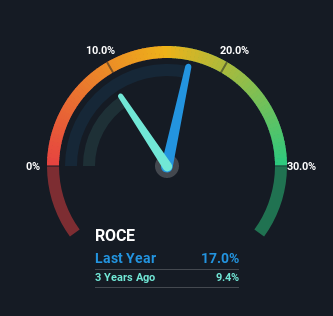Investors Will Want Epsilon Energy's (NASDAQ:EPSN) Growth In ROCE To Persist
Finding a business that has the potential to grow substantially is not easy, but it is possible if we look at a few key financial metrics. Amongst other things, we'll want to see two things; firstly, a growing return on capital employed (ROCE) and secondly, an expansion in the company's amount of capital employed. If you see this, it typically means it's a company with a great business model and plenty of profitable reinvestment opportunities. Speaking of which, we noticed some great changes in Epsilon Energy's (NASDAQ:EPSN) returns on capital, so let's have a look.
What is Return On Capital Employed (ROCE)?
For those who don't know, ROCE is a measure of a company's yearly pre-tax profit (its return), relative to the capital employed in the business. The formula for this calculation on Epsilon Energy is:
Return on Capital Employed = Earnings Before Interest and Tax (EBIT) ÷ (Total Assets - Current Liabilities)
0.17 = US$16m ÷ (US$99m - US$7.5m) (Based on the trailing twelve months to December 2021).
Thus, Epsilon Energy has an ROCE of 17%. In absolute terms, that's a satisfactory return, but compared to the Oil and Gas industry average of 10% it's much better.
Check out our latest analysis for Epsilon Energy
Historical performance is a great place to start when researching a stock so above you can see the gauge for Epsilon Energy's ROCE against it's prior returns. If you're interested in investigating Epsilon Energy's past further, check out this free graph of past earnings, revenue and cash flow.
So How Is Epsilon Energy's ROCE Trending?
We're delighted to see that Epsilon Energy is reaping rewards from its investments and is now generating some pre-tax profits. The company was generating losses five years ago, but now it's earning 17% which is a sight for sore eyes. Not only that, but the company is utilizing 37% more capital than before, but that's to be expected from a company trying to break into profitability. We like this trend, because it tells us the company has profitable reinvestment opportunities available to it, and if it continues going forward that can lead to a multi-bagger performance.
In another part of our analysis, we noticed that the company's ratio of current liabilities to total assets decreased to 7.6%, which broadly means the business is relying less on its suppliers or short-term creditors to fund its operations. So shareholders would be pleased that the growth in returns has mostly come from underlying business performance.
The Key Takeaway
To the delight of most shareholders, Epsilon Energy has now broken into profitability. Since the stock has returned a solid 53% to shareholders over the last five years, it's fair to say investors are beginning to recognize these changes. With that being said, we still think the promising fundamentals mean the company deserves some further due diligence.
On a separate note, we've found 1 warning sign for Epsilon Energy you'll probably want to know about.
While Epsilon Energy may not currently earn the highest returns, we've compiled a list of companies that currently earn more than 25% return on equity. Check out this free list here.
Have feedback on this article? Concerned about the content? Get in touch with us directly. Alternatively, email editorial-team (at) simplywallst.com.
This article by Simply Wall St is general in nature. We provide commentary based on historical data and analyst forecasts only using an unbiased methodology and our articles are not intended to be financial advice. It does not constitute a recommendation to buy or sell any stock, and does not take account of your objectives, or your financial situation. We aim to bring you long-term focused analysis driven by fundamental data. Note that our analysis may not factor in the latest price-sensitive company announcements or qualitative material. Simply Wall St has no position in any stocks mentioned.

